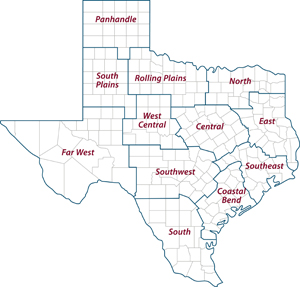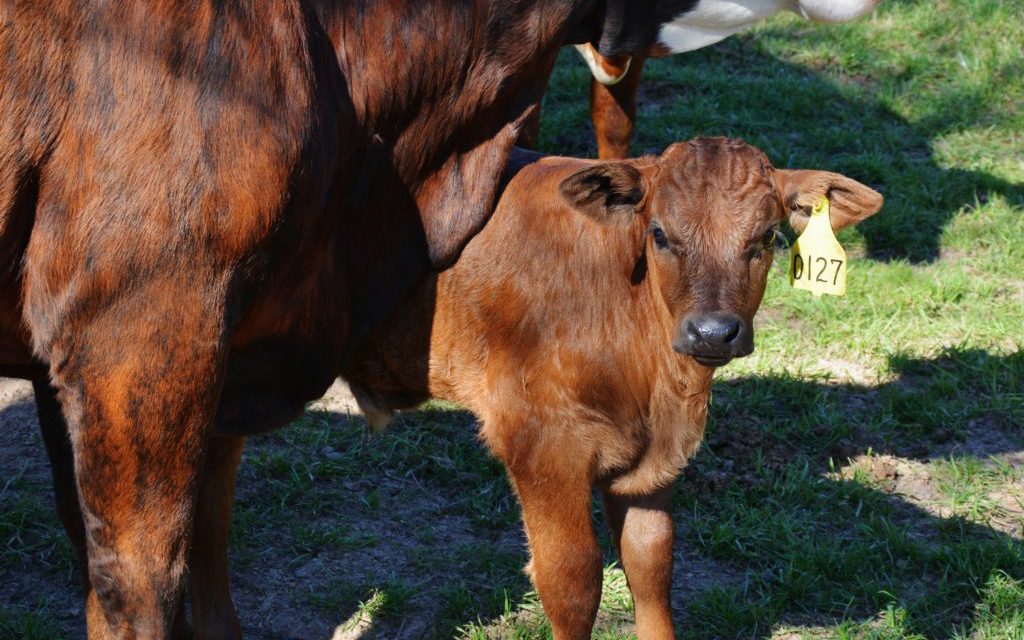Texas Crop and Weather Report – Sept. 24, 2019
- Writer: Adam Russell, 903-834-6191, adam.russell@ag.tamu.edu
- Contact: David Anderson, 979-845-4351, danderson@tamu.edu
Texas cattle producers are seeing fewer dollars in their pockets as prices remain low, while the Texas beef herd has hit an eight-year high of 4.65 million.
Beef cattle and calves are the state’s top agricultural commodity and generate sales of more than $10 billion annually in Texas.
Prices for Texas feeder steers averaged $145 per hundredweight, depending on weight and quality, according to the U.S. Department of Agriculture. That price is about $5 per hundredweight lower than the same time last year and about $33 per hundredweight lower than the five-year average. Prices dipped even further in mid-May and mid-August this year.
Reasons for price decline
David Anderson, Ph.D., Texas A&M AgriLife Extension Service economist, College Station, said multiple factors have caused prices to decline over the last few years, while others have caused prices to fluctuate this year.
A fire at a meat packing plant in Kansas in mid-August is one factor that contributed to lower cattle prices over the past month. The plant handled 6% of the nation’s fed cattle capacity.
The fire occurred at a time when many producers take fall calves to market adding to the bottleneck and oversupply of beef cattle headed to processing, he said.
“We did see an impact on fed-cattle prices and even calf prices,” he said. “That trickles down into wholesale beef prices. I don’t like to use the word panic, but there was some concern about what the loss of that plant would mean, and the market reacted. In my opinion, it overreacted.”
The plant is expected to reopen in early 2020.
Drought is another factor that contributed to prices trending downward, Anderson said. Producers were cutting herds earlier and thinner than usual, and some were shipping calves sooner.
Anderson said establishment of wheat pastures could create demand for stockers. But cattle prices likely won’t rise to levels experienced in 2014-2015 because the Texas and national cattle herds have recovered since the last major drought.
“We have peaked out when it comes to the U.S. herd, so the price incentive to grow it further isn’t there,” he said. “After the drought of 2011, growth of the herd was a reaction to high prices, but eventually growth lends to lower prices and contraction.”
Steady demand
There is good demand for beef, and feed prices are favorable, Anderson said.
Exports continue to be good, but the strength of the dollar has made U.S. beef less competitive compared to other beef-producing nations like Brazil and Australia. The ongoing trade war with China has had little effect on beef, but Anderson said exports to that nation have been growing.
Consumer niche markets in the U.S. such as plant-based “alternative proteins” have not made a measurable impact on the demand for beef, Anderson said. Plant-based alternatives have been around for years, and while they provide options for consumers, they make up a very small percentage of the market.
“There is a growing demand for beef and other proteins, whether we’re talking domestic or export markets,” he said. “I think if a producer’s calves are in good shape, and they have good grass and hay stocks, they might hang on to them to see if they catch an uptick in prices. But the days of $230-$300 per hundredweight are over because the herd has been replenished.”

AgriLife Extension district reporters compiled the following summaries:
CENTRAL: The district experienced another week of severe drought. Overcast skies and humidity produced dewy mornings, but the district missed out on rain from Tropical Storm Imelda. Many counties were under a burn ban. Producers were preparing for winter wheat planting. The ground was too hard to work seedbeds in some areas. Hay producers were hoping to make a final hay cutting, but grasses were not producing due to a lack of moisture. Pastures were declining. Early season pecans were near ready to harvest. Cotton harvest was underway, and grain harvests were winding down. Nearly all counties reported short soil moisture. Livestock were in good condition in nearly all counties.
ROLLING PLAINS: The district received much-needed rain with amounts up to 5 inches in some areas. Field conditions were favorable as some wheat producers continued to plant crops. Some cattle producers were feeding supplemental hay to stocker calves. Cotton fields were in fair to good condition, and bolls were opening. Some producers were spraying for fall armyworms in wheat and pastures.
COASTAL BEND: Most of the district received scattered showers, while some northern areas received varying amounts of heavier rainfall from Tropical Storm Imelda. The majority of crops were harvested, with the exception of several northern counties where the harvest of cotton and late-planted rice continued. Rains delayed cotton harvest in Wharton County, and lint and seed losses were likely to occur. Post-harvest fieldwork progressed. Pasture conditions improved throughout most of the district. Only a few counties reported supplemental feeding of livestock. Winter pasture preparation and planting continued. Livestock were in fair to good condition. Cull cows and weaned calves started to show up in some local auctions. Harvest of early pecan varieties began in DeWitt County.
EAST: Tropical Storm Imelda brought much-needed rain. Some counties received as much as 12 inches, while others reported less than 1 inch. Many areas did not receive rain amounts needed for pastures and fields to recover. Pasture and rangeland conditions were fair. Subsoil and topsoil conditions were adequate. Producers continued to hold out hope of getting another cutting of hay. Some were preparing land for small-grain planting. Livestock were doing fair to good. Reports of armyworms followed the rains. Bermuda grass stem maggots were also a problem. Wild pigs continued to cause damage across the district.
SOUTH PLAINS: Subsoil and topsoil moisture levels were still low even after rains. Some counties reported 1-4 inches. Some areas missed out on rainfall. Cotton bolls were still opening with about 50% open so far. A few dryland farmers were planning to defoliate their fields soon. Peanuts looked good and were pegging and putting more nuts on. Cattle were in good condition. Pumpkin harvest was in full swing.
PANHANDLE: Cotton was in fair condition in most areas. Pasture and rangeland conditions were fair to good. Corn was in good condition and progressing. Subsoil and topsoil were short to very short throughout the district. Some winter wheat was planted in most areas. Sorghum was mature in some areas.
NORTH: Soil moisture was short across the district. Light rains with most counties reporting trace amounts up to 1 inch. Red River and Titus counties reported nearly 3 inches of rainfall. Conditions were hot and dry in other areas, with some counties reporting cracking soil. Daytime temperatures were in the mid- to high-90s with 10-15 mph winds. Soybeans and cotton continued to decline from the heat and lack of moisture. Bermuda grass had gone dormant, and farmers were about two weeks behind on planting winter wheat due to a lack of soil moisture. Armyworms were reported, but nothing significant.
FAR WEST: High temperatures averaged in the low 90s with lows in the low 60s. Thunderstorms brought trace amounts up to 4 inches of rain. Several small grass fires were reported. All fires were contained or extinguished. Local cow/calf producers were preparing to rotate pastures. Cotton bolls continued to open. Cotton fields were harvested in a few places. White flies were spotted in many fields and could pose a problem for farmers. Pecan orchards looked very good with Pawnee pecan harvest to begin within a month. Livestock and wildlife continued to receive supplemental feed.
WEST CENTRAL: Light showers midweek did little to help soil moisture levels and forages. Wildfire risk was high, counties remained under burn bans. Field preparation continued for wheat and oats with some producers beginning to plant oats. The pecan crop looked promising in some areas, but supplemental water was important. Stock tank levels continued to decline, and many smaller tanks were close to dry. Livestock remained in average condition. Lighter weight steers, 300-475 pounds, sold steady, and 300-450-pound heifers sold $5 lower. Fleshy calves 500-600 pounds sold $5-$10 lower per hundredweight. Feeder steers and heifers sold $5 lower. Packer cows sold $2 lower per hundredweight, and bulls were $1 lower.
SOUTHEAST: Galveston County sustained heavy rains and experienced flooding in some areas. Walker County also received rain, but southern areas received much more than northern areas. Brazos County was extremely hot and dry. Fall armyworms were expected to follow the rains. Rangeland and pasture ratings were excellent to very poor with good being most common. Soil-moisture levels throughout district ranged from very short to surplus with surplus being most common.
SOUTHWEST: Unseasonably hot weather persisted, but Real County reported cool mornings and warm afternoons. Rains were spotty with limited amounts received. All cotton harvesting concluded. Fields were being prepared for winter wheat planting. Most farmers opted to delay wheat planting for another week due to extreme heat. Fall calving started. Fly infestations continued. Many producers continued to provide supplemental feed to livestock or were culling herds. Livestock and wildlife were in fair condition.
SOUTH: Conditions were warm with short to very short soil moisture levels in most areas, but a few counties reported adequate soil moisture. Southern areas reported mild temperatures. No rain was reported. Temperatures were in the mid-90s. Cotton harvest was in full swing in some areas and winding down in other areas. Above-average yields were reported. Peanuts were under irrigation and getting closer to harvest. Early strawberries were planted, and fieldwork was underway for mid-October plantings. Pasture and rangeland conditions in some areas were poor and declining due to lack of rainfall. But conditions improved in areas that received recent rains. Pastures were being monitored and treated for armyworms. Hay was being fed by some producers. Pasture conditions in some areas improved well enough for hay cutting. Cattle body conditions were steady in some areas and declining in especially dry areas. Irrigated crops, including Coastal Bermuda grass and vegetables, were in good condition. Spinach planting was expected to begin soon. Some cabbage was planted. Some had emerged and was making good progress. Onions and additional cabbage planting were expected after pre-planting irrigation was applied. Cotton gins were very busy.





